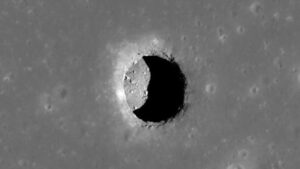In an astronomical breakthrough, NASA’s James Webb Space Telescope may have detected the first signs of extraterrestrial life.
The large telescope has already made several thrilling discoveries. Recently, it took a closer look at the atmosphere of a potentially habitable exoplanet about 120 light-years from Earth.
Researchers discovered an intriguing blend of chemicals in the atmosphere of an exoplanet known as K2-18b. Since one of those chemicals has a foul smell — and is only produced by phytoplankton here on Earth. Researchers jokingly referred to the chemical blend as “alien farts.”
The findings were recently published on the pre-print server arXiv. It will appear in a forthcoming issue of The Astrophysical Journal Letters, according to LiveScience.
K2-18b orbits a red dwarf star in the habitable zone. Initially discovered by NASA’s Kepler telescope in 2015, it’s about 2.6 times the size of Earth.
The exoplanet caught more attention in 2018 when NASA’s Hubble telescope discovered water vapor in its atmosphere. This unique profile, combined with its location in a habitable zone, make the planet an ideal candidate for extraterrestrial life.

Blooms of phytoplankton in the waters around England. A gas produced by the organisms has been found on an exoplanet. Image: Shutterstock/NASA
Searching for bio-signatures
The latest study uses the James Webb Space Telescope to analyze light that had passed through K2-18b’s atmosphere. That provided the most detailed atmospheric spectrum ever captured for a habitable planet, the researchers said.
The analysis revealed significant amounts of hydrogen, methane, and carbon dioxide, along with trace amounts of ammonia. These chemicals hint at K2-18b being a “Hycean” world: a type of exoplanet with a hydrogen-rich atmosphere and an icy mantle covered by an ocean.
However, while Hycean worlds are candidates for life, there’s no guarantee that the planet’s potential ocean has the right temperature and nutrients to support living organisms.
One of the most exciting findings was the trace detection of dimethyl sulfide (DMS), a foul-smelling chemical usually emitted by microscopic marine life in Earth’s oceans.
While more research is needed, the presence of DMS represents a tantalizing possibility, according to an official statement on the NASA website.
“This result was only possible because of [the James Webb telescope’s] unprecedented sensitivity,” said lead author and astrophysicist Nikku Madhusudhan.

The James Webb Space Telescope in Earth’s orbit. Image: Shutterstock/NASA
Implications and next steps
Hycean worlds like K2-18b are the most common type of planet in the galaxy, according to study co-author Subhajit Sarkar. With this new discovery, researchers hope to extend the search for extraterrestrial life beyond smaller rocky planets.
Plans are already underway for further observations of K2-18 b using the James Webb Space Telescope.
Finding more evidence of extraterrestrial life on the exoplanet “would transform our understanding of our place in the universe,” Madhusudhan said.






